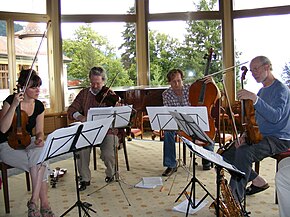
Back Strykkwartet Afrikaans رباعية وترية Arabic Gudački kvartet BS Quartet de corda Catalan Smyčcové kvarteto Czech Pedwarawd llinynnol Welsh Strygekvartet Danish Streichquartett German Κουαρτέτο εγχόρδων Greek Arĉa kvarteto Esperanto

The term string quartet refers to either a type of musical composition or a group of four people who play them. Many composers from the mid-18th century onwards wrote string quartets. The associated musical ensemble consists of two violinists, a violist, and a cellist. The double bass is almost never used in the ensemble mainly because it would sound too loud and heavy.
The string quartet was developed into its present form by the Austrian composer Joseph Haydn, whose works in the 1750s established the ensemble as a group of four more-or-less equal partners. Since that time, the string quartet has been considered a prestigious form; writing for four instruments with broadly similar characteristics both constrains and tests a composer. String quartet composition flourished in the Classical era, and Mozart, Beethoven and Schubert each wrote a number of them. Many Romantic and early-twentieth-century composers composed string quartets, including Mendelssohn, Schumann, Brahms, Dvořák, Janáček, and Debussy. There was a slight lull in string quartet composition later in the 19th century, but it received a resurgence in the 20th century, with the Second Viennese School, Bartók, Shostakovich, Babbitt, and Carter producing highly regarded examples of the genre, and it remains an important and refined musical form.
The standard structure for a string quartet as established in the Classical era is four movements, with the first movement in sonata form, allegro, in the tonic key; a slow movement in a related key and a minuet and trio follow; and the fourth movement is often in rondo form or sonata rondo form, in the tonic key.
Some string quartet ensembles play together for many years and become established and promoted as an entity in a similar way to an instrumental soloist or an orchestra.